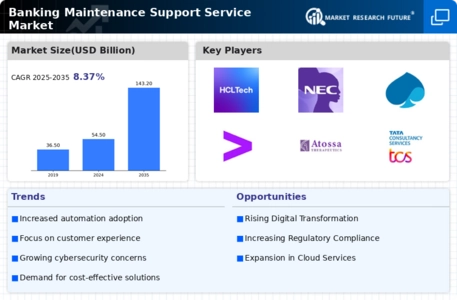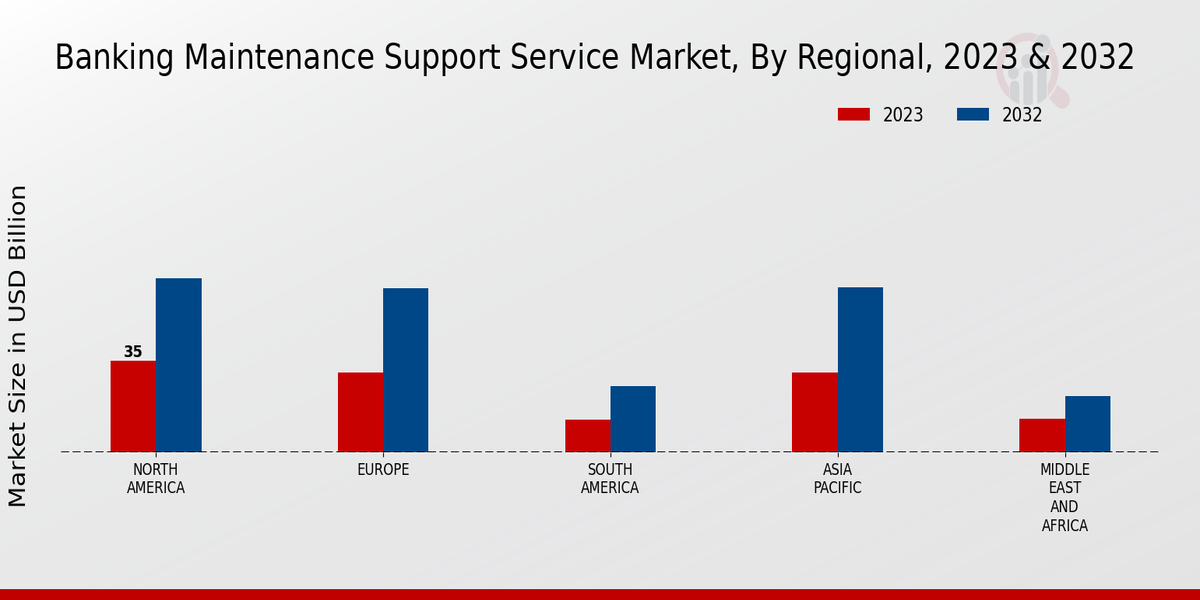Market Growth Chart
The Global Banking Maintenance Support Service Market Industry is poised for substantial growth, as illustrated in the accompanying chart. The market is expected to reach 54.5 USD Billion in 2024, with a remarkable increase to 143.2 USD Billion by 2035. The compound annual growth rate (CAGR) of 9.18% from 2025 to 2035 highlights the robust demand for maintenance support services in the banking sector, driven by various factors including technological advancements, regulatory compliance, and rising customer expectations.
Regulatory Compliance
Regulatory compliance remains a critical driver for the Global Banking Maintenance Support Service Market Industry. Financial institutions are mandated to adhere to stringent regulations aimed at safeguarding consumer interests and ensuring financial stability. Compliance requires robust maintenance support services to manage and monitor systems effectively. As regulations evolve, banks must invest in maintenance solutions that can adapt to these changes, thereby driving demand for specialized services. The anticipated growth in this sector is underscored by a projected market value of 143.2 USD Billion by 2035, reflecting the increasing complexity of compliance requirements.
Global Economic Growth
Global economic growth is a pivotal driver for the Global Banking Maintenance Support Service Market Industry. As economies expand, financial institutions experience increased transaction volumes and customer bases, necessitating enhanced maintenance support services to manage the growing demand. Economic growth fosters investment in technology and infrastructure, which in turn drives the need for efficient maintenance solutions. This trend is reflected in the market's projected growth trajectory, with an expected value of 54.5 USD Billion in 2024, as banks seek to capitalize on economic opportunities while ensuring operational efficiency.
Technological Advancements
The Global Banking Maintenance Support Service Market Industry is experiencing a surge due to rapid technological advancements. Innovations such as artificial intelligence, machine learning, and automation are streamlining maintenance processes, enhancing efficiency, and reducing operational costs. For instance, banks are increasingly adopting AI-driven chatbots for customer service, which not only improves user experience but also minimizes the need for extensive human intervention. This trend is expected to contribute to the market's growth, with projections indicating a market size of 54.5 USD Billion in 2024, as institutions seek to leverage technology to optimize their maintenance support services.
Rising Cybersecurity Threats
The rise in cybersecurity threats is a significant factor influencing the Global Banking Maintenance Support Service Market Industry. As financial institutions digitize their operations, they become more vulnerable to cyberattacks, necessitating robust maintenance support services to protect sensitive data and ensure system integrity. Banks are investing heavily in cybersecurity measures, which include regular system maintenance and updates to safeguard against potential breaches. This focus on security is likely to propel the market forward, as institutions prioritize the implementation of comprehensive maintenance strategies to mitigate risks associated with cyber threats.
Increased Customer Expectations
Increased customer expectations are reshaping the Global Banking Maintenance Support Service Market Industry. As consumers demand seamless and efficient banking experiences, financial institutions are compelled to enhance their service offerings through improved maintenance support. This includes ensuring system uptime, rapid issue resolution, and personalized services. Banks that fail to meet these expectations risk losing customers to competitors who prioritize superior maintenance solutions. Consequently, the market is projected to grow at a CAGR of 9.18% from 2025 to 2035, driven by the need to elevate customer satisfaction and loyalty through effective maintenance strategies.



















Leave a Comment